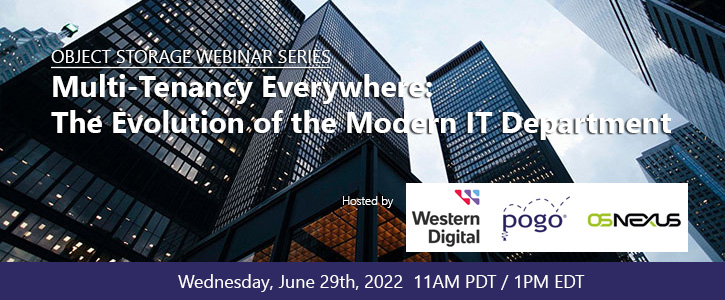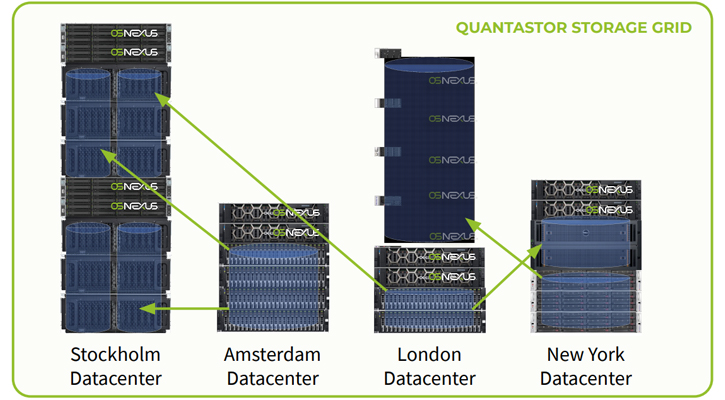Data Center Strategy: Multi-Tenancy Everywhere All At Once with Object Storage

Technology departments experienced a boost in productivity through the adoption of public cloud methodologies, where storage, compute, and applications can be deployed on-demand. However, the adoption of remote and hybrid work throughout the pandemic accelerated the digital transformation that IT organizations had already been undergoing by months, even years.
The new ease with which compute, storage, and applications can be deployed through public cloud technologies from the major service providers have fundamentally changed how IT departments think about security and think about how they provision compute and storage. This increased agility has IT organizations looking for ways to deliver that same agility in their hybrid-cloud environments to support a multitude of users.
At the same time, diligence in security is needed to compartmentalize departments within larger organizations as “tenants”, similar to how the public cloud operates, as this provides greater security and provides a mechanism for charge-back accounting to departments based on their use of compute and storage resources, just like the public cloud.
In this article, we’re going to focus mostly on the storage technologies that enable IT teams to implement multi-tenancy for their organizations.
Researching multi-tenant storage infrastructures that prevent ransomware attacks or a data loss event? Here’s what data center administrators need to know to design a secure multi-tenancy architecture with object storage. Questions? Drop us an email at or book a meeting with a sales advisor.
🏢 How multi-tenancy architecture assists the digital transformation
As organizations continue their pre-pandemic digital transformation and shift to the cloud and containers, remote workers access the same data across different regions. As a result, data is stored everywhere now, which is increasing the level of data exposure and making IT departments susceptible to data breaches and ransomware.
Introducing Multi-Tenancy: These two driving requirements for greater agility and security come together under the umbrella of multi-tenancy. A multi-tenant architecture in a single infrastructure instance, such as an object storage hardware and software solution, can serve multiple, distinct user groups. Secure object storage with multi-tenancy enables users to access their data – wherever the data is stored, wherever the user is working – while ensuring fluid business continuity and peace of mind without sacrificing performance and scalability.
How does a multi-tenant architecture for object storage provision resources?
When deploying multi-tenant environments in object storage, hardware resources (compute, storage, networking) can be divided into separate namespaces, or separate access to specific networks when deploying file and block storage. This dramatically simplifies charge-back accounting to departments within larger organizations, or clients for managed-service providers (MSPs).
How does multi-tenancy play into the network architecture?
Large cloud service providers divide up customers into their own VLAN(s) so that all of their network traffic is separated from other customers (tenants) in the shared network and server environments. When setting up the networking infrastructure for multi-tenancy it’s important to choose switches with solid VLAN feature sets that’ll scale efficiently with the datacenter.
How does multi-tenancy work with object storage?
Object storage systems generally provide Amazon S3-compatible object storage so that applications written to use the S3-protocol can work using the exact same APIs using dedicated S3-compatible storage that’s more cost-effective and performant.
One of the benefits of Ceph-based object storage systems used with platforms like OSNexus QuantaStor is that each tenant has their own namespace for all of their S3 “buckets”. This makes it easy to keep the storage for different customers and departments completely separate.
How to Design a Multi-tenant Object Storage Solution
To accelerate the adoption of multi-tenant environments, we’ve partnered with OSNexus and Western Digital to provide data center users with a diverse range of data protection and security breach protection requirements an integrated hardware and software solution. Pogo Linux StorageDirector appliances have deep hardware integration with Western Digital high-performance, low-latency NVMe flash storage and NVMe-over-Fabric networking, and the powerful file-, block- and object storage backup capabilities in the OSNexus software-defined storage platform.
If you’d like to learn more about how Pogo Linux storage solutions enable secure multitenant environments that prevent ransomware attacks or a data loss event, give us a call at (888) 828-7646, email us at or book a time calendar to speak. We’ve helped organizations of all sizes deploy scalable, high-performance object storage solutions for just about every IT budget.



